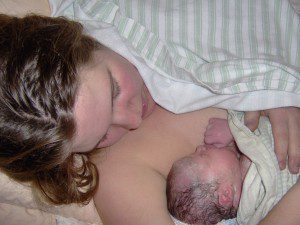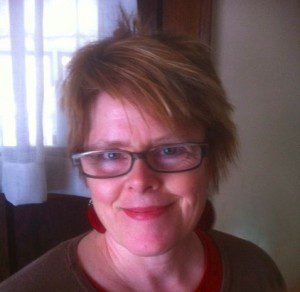By Aszani Stoddard, CNM, IBCLC
 Imagine being a newborn. You have been cradled in a warm, dark, watery environment. You have heard your mother’s heartbeat, the voices of family members and the sounds of your mother’s environment. Bathed in her hormones, you have instinctively pushed with your legs as she pushed you out. You have emotions, but no words for them. You have lots of instincts to guide you. And now you are here.
Imagine being a newborn. You have been cradled in a warm, dark, watery environment. You have heard your mother’s heartbeat, the voices of family members and the sounds of your mother’s environment. Bathed in her hormones, you have instinctively pushed with your legs as she pushed you out. You have emotions, but no words for them. You have lots of instincts to guide you. And now you are here.
Imagine that your first experience of the world is being greeted with fear. You are handled roughly and dried aggressively with a baby blanket. A bulb syringe is plunged into your throat. Your known oxygen supply, the umbilical cord, is quickly clamped and cut and you are whisked off of your mother for another round of suctioning under the warmer. You might be weighed, measured and dosed with Vitamin K and erythromycin eye ointment before your mom ever takes a good look at you. You are presented to her wrapped tightly in blankets. Often, at this point, you are overwhelmed and your eyes are closed. Even if you opened them, you would not be able to see her, the source of your life, through the Erythromycin ointment.
At some point, if your mother has planned on nursing you, you will be arranged across her body, and be woken up. If you show signs of interest, a well-intentioned person will assist your mother in latching you. This might include pushing you onto the nipple or putting a little formula on your mother’s nipple to entice you to nurse.
Let’s stop for a moment and consider the messages we have given to the Mother-Baby dyad so far:
1-The world is a scary place
2-The transition from the intrauterine to the extrauterine environment cannot happen without intervention
3-Medical intervention supercedes instinctual behavior
4-The convenience of medical people is more important than the needs of the mother-baby dyad
5-Breastfeeding is difficult, perhaps even impossible, and babies cannot stay healthy without our intervention.
Breastfeeding Is a Public Health Issue
Is it any wonder that many babies do not nurse well at first? That 75% of women in the United States initiate breastfeeding and only 15% are exclusively nursing at 6 months? (1)
It is estimated that about $13 billion would be saved if breastfeeding were increased from current levels to 90% of women breastfeeding exclusively for six months.
This number includes only savings for children’s health. This number does not factor in the protective health benefits for the mother, or the psychological benefits for the Mother-Baby dyad.
What the Data Tells Us:
- Undisturbed skin-to-skin contact (also known as Kangaroo Care) immediately after birth promotes:
- Breastfeeding success in the short-and long-term
- Mother and infant bonding
- Regulation of normal temperature, breathing and heart rates, blood pressure and blood sugar for the newborn
- Decreased stress for babies and mothers
- Improved immunity for infants
- Improved infant survival and decreased hospital stays for sick and premature newborns, even in settings with overcrowding and poor resources (3 & 4)
What My Experience Tells Me:
With over a decade of helping women in home and birth center settings and over twenty years in hospital settings, I have seen instinctual behavior happen in all settings. But it only happens if we (the care providers) get out of the way.
Yes, I’m saying that less is better. That we cause harm by intervening too much.
How Can We Do Better?
- First, place the baby immediately onto the mother’s abdomen after the birth.
- GENTLY dry the baby, remove the wet blankets and cover the baby and mother with warm blankets right away. THERE IS NO NEED TO SUCTION A HEALTHY BABY. Gently wipe the face as you do the body. Talk to the baby and welcome it to the world.
- Avoid anything that could potentially cause harm to the breastfeeding process, including use of the bulb syringe and deep suctioning. DO NOT suction the stomach because “the baby is spitting up”. No special measures are needed for babies born with meconium-stained fluid unless there is a need for ventilations. (5).
- Learn how normal newborns transition from amniotic-fluid breathing to air-breathing creatures. Know how to spot the difference between normal and abnormal transition. Educate and talk with parents to point out what you are seeing and looking for after the birth.
- In every setting, institute a “Sacred Hour” after the birth. This includes minimal contact from anyone but the mother and partner. Vital signs should be taken minimally, and always with the baby skin-to-skin with the mother and covered with blankets. Visitors should be limited during this time.
- Infants should be given at least an hour to self-attach at the breast. Educate families and staff about normal infant behavior during this time. Refrain from forcing a newborn onto the nipple.
- Learn about instinctual infant behavior and how to optimize infant positioning for successful breastfeeding
- Keep the baby “in the habitat” (skin-to-skin with the mother), even during assessments like blood sugar testing. If blood sugar is low, nurse first. If the baby isn’t nursing, supplement at the breast with the baby in the habitat., preferably with donor human milk.
- ALWAYS include the parents in decision-making. Avoid paternalistic behavior. Use the midwifery model (which can be used by anyone doing maternity care), which emphasizes shared decision-making (6).
- Always think about how to best adapt care to be “Mother-Baby Centered”. Be innovative and fearless in protecting the habitat for newborns.
Postscript:
Although many researchers have studied this issue, a few people deserve special recognition:
Over the last 35 years, Drs. John H. Kennell (a pediatrician) and Marshall H. Klaus (a neonatologist) have helped us to understand physiologic and behavioral processes of mothers and babies around the time of birth. In turn, they have helped modify obstetric and newborn care to enhance the remarkable inborn capacity of mother and infant to promote their mutual welfare.
Dr Nils Bergman, working in South Africa, has also extensively studied this area, and coined the term “the habitat” for keeping the newborn skin-to-skin with its mother.
Resources:
An excellent and quick look at why skin-to-skin care is so important, from one of our renowned world experts, Dr. Nils Bergman:
http://www.skintoskincontact.com/what-is-ssc.aspx
Dr. Nils Bergman’s sister website on Kangaroo Care:
http://www.kangaroomothercare.com/
Excellent videos for staff in hospitals and parents about how to recognize the normal stages of infant self-attachment at breast:
http://www.healthychildren.cc/skin2skin.htm
Evidence-based resources for maternity health care, including the “Listening to Women” Survey:
http://www.childbirthconnection.org/
For an outline of the 10 Steps for Baby-Friendly Care:
http://www.babyfriendlyusa.org/
For an outline of Mother-Friendly Care:
http://www.motherfriendly.org/MFCI
A summary of the work by Drs. Kennell and Klaus:
http://www.childbirthconnection.org/pop.asp?ck=10469
References:
1- http://www.cdc.gov/breastfeeding/data/NIS_data/index.htm
2-http://www.ncbi.nlm.nih.gov/pubmed/20368314
3-A bibliography from a talk given by Barbara Morrison, PhD, FNP, CNM, in 2006 at the International Network of Kangaroo Mother Care Biennial Workshop
http://kangaroo.javeriana.edu.co/encuentros/6encuentro/abstract2.pdf
4-A comprehensive overview of the literature from Case Western Reserve University:
http://fpb.cwru.edu/kangaroocare/KCBIB%20abstracts.pdf
Review of the current NRP Guidelines:
5- http://www.aafp.org/afp/2011/0415/p911.html
The definition of the Midwife Model of Care:
6- http://cfmidwifery.org/mmoc/define.aspx
 Aszani Stoddard is a nurse-midwife and International Board Certified Lactation Consultant (IBCLC) who has worked in home, birth center and hospital settings for the last thirty years. Aszani is the founder of the Madison Birth Center (www.madisonbirthcenter.com), Wisconsin’s first Nationally Accredited and Baby-Friendly free-standing birth center. She now works in a woman-centered hospital practice in Minneapolis. She remains an active part of the birth center community by serving on committees and serving as a bridge between home, birth center and hospital cultures.
Aszani Stoddard is a nurse-midwife and International Board Certified Lactation Consultant (IBCLC) who has worked in home, birth center and hospital settings for the last thirty years. Aszani is the founder of the Madison Birth Center (www.madisonbirthcenter.com), Wisconsin’s first Nationally Accredited and Baby-Friendly free-standing birth center. She now works in a woman-centered hospital practice in Minneapolis. She remains an active part of the birth center community by serving on committees and serving as a bridge between home, birth center and hospital cultures.
The Thoughtful Midwife: Fearlessly combining research and traditional midwifery wisdom to guide maternal and infant health care.
To subscribe to Debra’s Pleasurable Weekly enews please click here.
Aszani you speak the truth. It is so easy for us at home to honor the Golden Hour. Thank you for continuing to educate the hospital world about this sacred time for both mothers and babies.
You are such hero to so many mamas and babies! Thank you for being there for my daughter’s birth! Your gentle touch has meant so much to me and I love you so much. God bless you in this precious work that you do.
Laurie –I am so proud of the work you do—-It is a wonderful article—
Love, Aunt Flossie
Dear, dear Azani. I could not help but notice your happy face while often passing in the halls of the AABC Birth Iwas clear to me you have moved into a special space in your life and the above comment, which I love, confirms it. We never really know where the forces of the universe will take us if we can just stay open to the possibilities. I’m so proud of you! BTW are you using the AABC PDR? I wish you would so we cna demonstrate that the place of birth while extreme;y important, is not the key issue for improving care of ALL childbearing women.
Kitty